The Christmas Song (Chestnut Roasting on an Open Fire): Nat King Cole
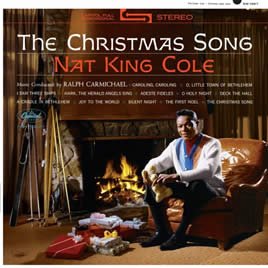
The Christmas Song (Chestnut Roasting on an Open Fire): Nat King Cole is a classic Christmas song written in 1945 by Bob Wells and Mel Tormé.
According to Tormé, the song was written during a blistering hot summer. In an effort to “stay cool by thinking cool”, the most-performed (according to BMI) Christmas song was born. “I saw a spiral pad on his (Wells’) piano with four lines written in pencil”, Tormé recalled. “They started, ‘Chestnuts roasting…, Jack Frost nipping…, Yuletide carols…, Folks dressed up like Eskimos.’ Bob didn’t think he was writing a song lyric. He said he thought if he could immerse himself in winter he could cool off. Forty minutes later that song was written. I wrote all the music and some of the lyrics.”
The Nat King Cole Trio first recorded the song early in 1946. At Cole’s behest – and over the objections of his label, Capitol Records – a second recording was made later the same year utilizing a small string section, this version becoming a massive hit on both the pop and R&B charts. Cole again recorded the song in 1953, using the same arrangement with a full orchestra arranged and conducted by Nelson Riddle, and once more in 1961, in a stereophonic version with orchestra conducted by Ralph Carmichael. Cole’s 1961 version is generally regarded as definitive, and in 2004 was the most-loved seasonal song with women aged 30–49, while the original 1946 recording was inducted into the Grammy Hall of Fame in 1974
White Christmas: Bing Crosby
White Christmas: Bing Crosby
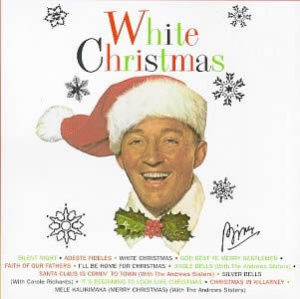 is a 1942 Irving Berlin song reminiscing about an old-fashioned Christmas setting. According to the Guinness World Records, the version sung by Bing Crosby is the best-selling single of all time, with estimated sales in excess of 100 million copies worldwide. Other versions of the song, along with Crosby’s, have sold over 150 million copies.
is a 1942 Irving Berlin song reminiscing about an old-fashioned Christmas setting. According to the Guinness World Records, the version sung by Bing Crosby is the best-selling single of all time, with estimated sales in excess of 100 million copies worldwide. Other versions of the song, along with Crosby’s, have sold over 150 million copies.
The first public performance of the song was by Bing Crosby, on his NBC radio show The Kraft Music Hall on Christmas Day, 1941; a copy of the recording from the radio program is owned by Crosby’s estate and was loaned to CBS News Sunday Morning for their December 25, 2011, program.
He subsequently recorded the song with the John Scott Trotter Orchestra and the Ken Darby Singers and Chorus for Decca Records in just 18 minutes on May 29, 1942, and it was released on July 30 as part of an album of six 78-rpm discs from the musical film Holiday Inn.
At first, Crosby did not see anything special about the song. He just said “I don’t think we have any problems with that one, Irving.” The song established and solidified the fact that there could be commercially successful secular Christmas songs — in this case, written by a Jewish-American songwriter, who also wrote “God Bless America.”
The song initially performed poorly and was overshadowed by Holiday Inn’s first hit song: “Be Careful, It’s My Heart”. By the end of October 1942, “White Christmas” topped the Your Hit Parade chart. It remained in that position until well into the new year. It has often been noted that the mix of melancholy — “just like the ones I used to know” — with comforting images of home — “where the treetops glisten” — resonated especially strongly with listeners during World War II. A few weeks after the attacks on Pearl Harbor, Crosby introduced “White Christmas” on a Christmas Day broadcast. The Armed Forces Network was flooded with requests for the song. The recording is noted for Crosby’s whistling during the second chorus.
In 1942 alone, Crosby’s recording spent eleven weeks on top of the Billboard charts. The original version also hit number one on the Harlem Hit Parade for three weeks, Crosby’s first-ever appearance on the black-oriented chart. Re-released by Decca, the single returned to the #1 spot during the holiday seasons of 1945 and 1946 (on the chart dated January 4, 1947), thus becoming the only single with three separate runs at the top of the U.S. charts. The recording became a chart perennial, reappearing annually on the pop chart twenty separate times before Billboard magazine created a distinct Christmas chart for seasonal releases.
In Holiday Inn, the composition won the Academy Award for Best Original Song in 1942. In the film, Crosby sings “White Christmas” as a duet with actress Marjorie Reynolds, though her voice was dubbed by Martha Mears. This now-familiar scene was not the movie-makers’ initial plan. In the script as originally conceived, Reynolds, not Crosby, would sing the song. The song would feature in another Crosby film, the 1954 musical White Christmas. White Christmas became the highest-grossing film of 1954.
The version most often heard today on radio during the Christmas season is the 1947 re-recording. The 1942 master was damaged due to frequent use. Crosby re-recorded the track on March 19, 1947, accompanied again by the Trotter Orchestra and the Darby Singers, with every effort made to reproduce the original recording session. The re-recording is recognizable by the addition of flutes and celesta in the beginning.
Although Crosby dismissed his role in the song’s success, saying later that “a jackdaw with a cleft palate could have sung it successfully,” he was associated with it for the rest of his career.
Blue Christmas: Elvis Presley
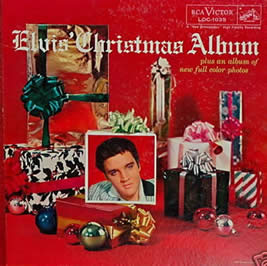 Blue Christmas: Elvis Presley is a Christmas song written by Billy Hayes and Jay W. Johnson and most famously performed by Elvis Presley. It is a tale of unrequited love during the holidays and is a longstanding staple of Christmas music, especially in the country genre.
Blue Christmas: Elvis Presley is a Christmas song written by Billy Hayes and Jay W. Johnson and most famously performed by Elvis Presley. It is a tale of unrequited love during the holidays and is a longstanding staple of Christmas music, especially in the country genre.
The song was first recorded by Doye O’Dell in 1948, and was popularized the following year in three separate recordings: one by country artist Ernest Tubb; one by musical conductor and arranger Hugo Winterhalter and his orchestra and chorus; and one by bandleader Russ Morgan and his orchestra (the latter featuring lead vocals by Morgan and backing vocals by singers credited as the Morganaires).
Tubb’s version spent the first week of January 1950 at No. 1 on Billboard magazine’s Most-Played Juke Box (Country & Western) Records chart, while Winterhalter’s version peaked at No. 9 on Billboard’s Records Most Played by Disk Jockeys chart and Morgan’s version reached No. 11 on Billboard’s Best-Selling Pop Singles chart. Both Morgan’s and Winterhalter’s versions featured a shorter pop edit of the original lyrics. Also in 1950 crooner Billy Eckstine recorded his rendition, backed by the orchestra of Russ Case, with these shortened lyrics in a variation close to what is now the common standard for this song; the orchestral backing of this recording has often been wrongly accredited to Winterhalter.
Elvis Presley cemented the status of “Blue Christmas” as a rock-and-roll holiday classic by recording it for his 1957 LP Elvis’ Christmas Album. Presley’s version is notable musicologically as well as culturally in that the vocal group the Jordanaires (especially in the soprano line, sung by Millie Kirkham) replace many major and just minor thirds with neutral and septimal minor thirds, respectively. In addition to contributing to the overall tone of the song, the resulting “blue notes” constitute a musical play on words that provides an “inside joke” or “Easter egg” to trained ears. “Blue Christmas” was also included on a 1957 45 EP (Extended Play) entitled Elvis Sings Christmas Songs (EPA-4108), which also included “Santa Bring My Baby Back (To Me)” on side one, with “Santa Claus Is Back in Town” and “I’ll Be Home for Christmas” on side two. Presley’s original 1957 version was released as a commercially available single for the first time in 1964. This single was also a hit in the United Kingdom, reaching No. 11 on the British singles chart during the week of 26 December 1964.
The rock band The Beach Boys recorded a version featuring Brian Wilson on lead vocals, releasing it in the United States on November 16, 1964, in two separate formats simultaneously:
(a) the B-side of the “The Man with All the Toys” single.
(b) a track on The Beach Boys’ Christmas Album.
Jingle Bell Rock: Bobby Helms
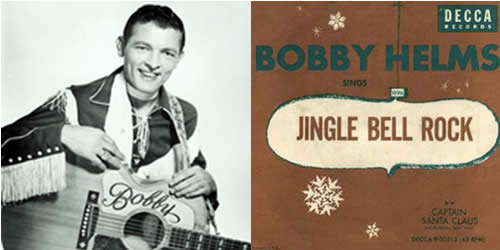
Jingle Bell Rock: Bobby Helms is an American popular Christmas song first released by Bobby Helms in 1957. It has received frequent airplay in the United States during every Christmas season since then. “Jingle Bell Rock” was composed by Joseph Carleton Beal (1900–1967) and James Ross Boothe (1917–1976).
Beal was a Massachusetts-born public relations professional and longtime resident of South Ocean Avenue in Atlantic City, New Jersey, and Boothe was an American writer in the advertising business.
Jingle Bell Rock” has been performed by many, but Helms’ version is the best known. The song’s title and some of its lyrics are an extension of the old Christmas standard, “Jingle Bells.” It makes brief references to other popular songs of the 1950s, such as “Rock Around the Clock,” and mentions going to a “Jingle hop.” An electric guitar played by Hank Garland can be heard playing the first notes of the chorus of “Jingle Bells.” Backup singers were the Anita Kerr Quartet.
Bobby Helms’ original version, on Decca 9-30513 from 1957, was re-recorded by him on Kapp K-719 in 1965, and yet again in 1967 on Little Darlin’ LD-0038. In 1970, Helms recorded an entire album titled Jingle Bell Rock on Certron C-7013, releasing the title track on Certron C-10021, with a picture sleeve. In yet another re-recording, Helms released a version on Ashley AS-4200 (year unknown). In 1983, Helms released his last recording of “Jingle Bell Rock” on Black Rose 82713.
Rockin’ Around the Christmas Tree: Brenda Lee
 Rockin’ Around the Christmas Tree: Brenda Lee is a Christmas song written by Johnny Marks and recorded by Brenda Lee in 1958. By the song’s 50th anniversary in 2008, Brenda Lee’s original version had sold over 25 million copies with the 4th most digital downloads sold of any Christmas single, and has since been recorded by numerous other music artists. Despite her mature-sounding voice, Lee recorded this song when she was only thirteen years old.
Rockin’ Around the Christmas Tree: Brenda Lee is a Christmas song written by Johnny Marks and recorded by Brenda Lee in 1958. By the song’s 50th anniversary in 2008, Brenda Lee’s original version had sold over 25 million copies with the 4th most digital downloads sold of any Christmas single, and has since been recorded by numerous other music artists. Despite her mature-sounding voice, Lee recorded this song when she was only thirteen years old.
The song’s declaration of a rock and roll sound notwithstanding, its instrumentation also fits the country music genre, which Brenda Lee more fully embraced as her career evolved. The recording features Grady Martin’s ringing guitar and Boots Randolph’s swinging solo sax break. Veteran session player Buddy Harman is the drummer. The song is written in the key of A-flat major. Although Decca released the single in both 1958 and again in 1959, it did not sell well until Lee became a popular star in 1960. That Christmas holiday season, Lee’s “Rockin’ Around the Christmas Tree” peaked at No. 14 on the Billboard Hot 100 pop singles chart.
It continued to sell well during subsequent holiday seasons, peaking as high as No. 3 on Billboard’s Christmas Singles chart in December 1965.
It peaked at No. 6 in the UK Charts, when it was released there in 1963, in 2013 due to downloads it became one of a number of songs to re-enter the UK Singles Chart near Christmas time along with Slade and The Pogues “Fairytale of New York”, Rockin’ Around the Christmas Tree”, it peaked at No. 63 on Sunday 15 December 2013.
For decades, Brenda Lee’s recording was the only notable version of the song. Radio stations ranging from Top 40 to Adult Contemporary to Country Music to Oldies to even Adult Standards played this version. Lee’s recording still receives a great deal of airplay, and has since turned into a perennial holiday favorite
Rudolph the Red Nosed Reindeer: Gene Autry
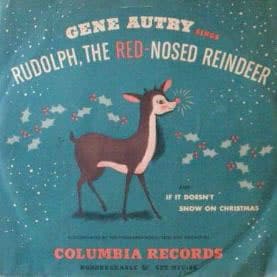 Rudolph the Red Nosed Reindeer: Gene Autry is a song written by Johnny Marks based on the 1939 story Rudolph the Red-Nosed Reindeer published by the Montgomery Ward Company. In 1939 Marks’ brother-in-law, Robert L. May, created the character Rudolph as an assignment for Montgomery Ward, and Marks decided to adapt the story of Rudolph into a song. Marks (1909–1985) was a radio producer who also wrote several other popular Christmas songs.
Rudolph the Red Nosed Reindeer: Gene Autry is a song written by Johnny Marks based on the 1939 story Rudolph the Red-Nosed Reindeer published by the Montgomery Ward Company. In 1939 Marks’ brother-in-law, Robert L. May, created the character Rudolph as an assignment for Montgomery Ward, and Marks decided to adapt the story of Rudolph into a song. Marks (1909–1985) was a radio producer who also wrote several other popular Christmas songs.
The song had an added introduction, stating the names of the eight reindeer which went:
“You know Dasher and Dancer and Prancer and Vixen,
Comet and Cupid and Donner and Blitzen,
But do you recall
The most famous reindeer of all?”
The song was sung commercially by crooner Harry Brannon on New York City radio in early November 1949, before Gene Autry’s recording hit No. 1 in the U.S. charts the week of Christmas 1949. Autry’s version of the song also holds the distinction of being the only chart-topping hit to fall completely off the chart after reaching No. 1. The official date of its No. 1 status was for the week ending January 7, 1950, making it the first No. 1 song of the 1950s.
The Little Drummer Boy: Harry Simeone Chorale
The Little Drummer Boy: Harry Simeone Chorale.
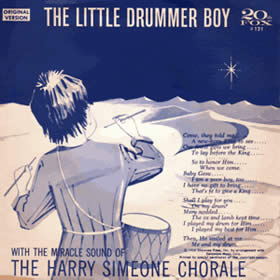 A popular Christmas song written by the American classical music composer and teacher Katherine Kennicott Davis in 1941.
A popular Christmas song written by the American classical music composer and teacher Katherine Kennicott Davis in 1941.
It was recorded in 1951 by the Trapp Family Singers and realised on the choir’s first lp Christmas with the Trapp Family Singers and released as a single (45rpm). These were the first recordings released on their new record label Decca Records and further popularized by a 1958 recording by the Harry Simeone Chorale. This version was re-released successfully for several years and the song has been recorded many times since.
In the lyrics the singer relates how, as a poor young boy, he was summoned by the Magi to the nativity where, without a gift for the infant Jesus, he played his drum with the Virgin Mary’s approval, remembering “I played my best for Him” and “He smiled at me.”
Happy Xmas (War Is Over): John Lennon and Yoko Ono/Plastic Ono Band
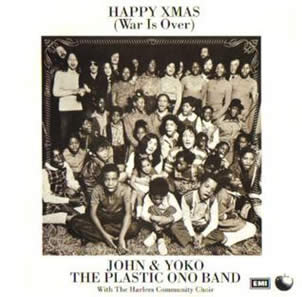 Happy Xmas (War Is Over): John Lennon and Yoko Ono/Plastic Ono Band is a Christmas song with lyrics by John Lennon and Yoko Ono, released in 1971 as a single by John & Yoko/Plastic Ono Band with the Harlem Community Choir. The lyrics are set to the traditional English ballad “Skewball”.
Happy Xmas (War Is Over): John Lennon and Yoko Ono/Plastic Ono Band is a Christmas song with lyrics by John Lennon and Yoko Ono, released in 1971 as a single by John & Yoko/Plastic Ono Band with the Harlem Community Choir. The lyrics are set to the traditional English ballad “Skewball”.
It was the seventh single release by Lennon outside of his work with the Beatles. The song reached number 4 in the UK, where its release was delayed until November 1972, and has periodically reemerged on the UK Singles Chart, most notably after Lennon’s death in 1980, at which point it peaked at number 2. Also a protest song against the Vietnam War, “Happy Xmas (War Is Over)” has since become a Christmas standard, frequently covered by other artists, appearing on compilation albums of seasonal music, and named in polls as a holiday favorite. “Happy Xmas (War Is Over)” was the culmination of more than two years of peace activism undertaken by John Lennon and Yoko Ono that began with the bed-ins they convened in March and May 1969, the first of which took place during their honeymoon.
The song’s direct antecedent was an international multimedia campaign launched by the couple in December 1969 – at the height of the counterculture movement and its protests against America’s involvement in the Vietnam War – that primarily consisted of renting billboard space in 12 major cities around the world for the display of black-and-white posters that declared “WAR IS OVER! If You Want It – Happy Christmas from John & Yoko”.
Although this particular slogan had previously appeared in the 1968 anti-war songs “The War Is Over” by Phil Ochs and “The Unknown Soldier” by the Doors (which features the refrain “The war is over”), its subsequent use by Lennon and Ono may just be coincidental; there is no evidence to confirm whether or not they were acquainted with these earlier works.
Recognizing the accessibility and popular appeal that made his 1971 single “Imagine” a commercial success compared to the other songs he had released up to that point, Lennon concluded, “Now I understand what you have to do: Put your political message across with a little honey.”
He conceived “Happy Xmas (War Is Over)” as a means of elaborating upon the themes of social unity and peaceful change enacted through personal accountability and empowerment that served as the basis of the earlier billboard campaign, trying to convey optimism while avoiding the sentimentality that he felt often characterized music of the holiday season.
Lennon was the first among the former Beatles to release an original Christmas song after the group disbanded in 1970. “Happy Xmas (War Is Over)” would be followed by George Harrison’s “Ding Dong, Ding Dong” (1974), Paul McCartney’s “Wonderful Christmastime” (1979) and Ringo Starr’s album I Wanna Be Santa Claus (1999). From 1963 to 1969, the Beatles issued special recordings at Christmas directly to members of their fan club
